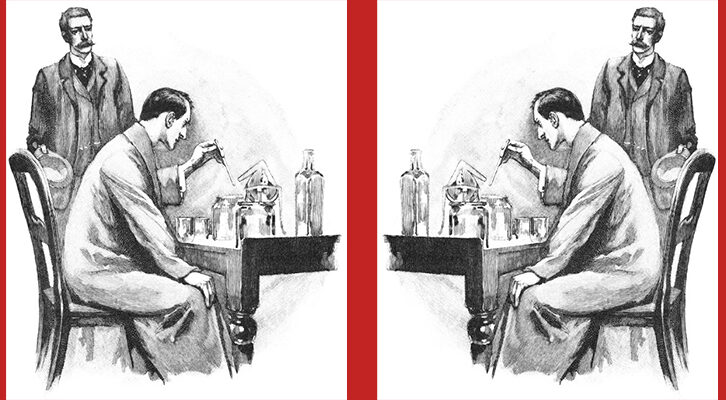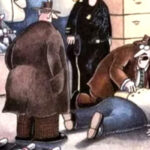
Ann Goldstein on Translating Elena Ferrante and the Inner Workings of The New Yorker
Melinda Harvey in Conversation with the Translator of the Neapolitan Novels
This essay appears in the new issue of The Lifted Brow.
If you count reading Elena Ferrante’s Neapolitan novels amongst your greatest book-related pleasures, then chances are you understand the urge I felt to buy her English translator, Ann Goldstein, a thank you drink. One would think that lobby bars, like New York City and bullfrogs, never sleep. But this was not the case one May afternoon at the five-star Melbourne hotel where Goldstein and I had agreed to meet, the day before her appearance at The Wheeler Centre. The drink was non-negotiable, so we ventured out. In person, Goldstein is warm and unpretentious. I felt like we had made some sort of connection. And yet there was the impression—even after a whiskey neat turned into a chateaubriand turned into a late-night visit to a tiny bookshop—of reserve, of a keen sense of the gratuitous and a desire to avoid it. Is it in the DNA of translators, who live by channelling authors, to hold their own selves somewhat in check?
Melinda Harvey: You have recently translated Jhumpa Lahiri’s In Other Words, which tells the story of her “indiscreet, absurd” love of the Italian language, which leads her to relocate to Rome and abandon reading and writing in English. Is your relationship with Italy and the Italian language in any way comparable to hers?
Ann Goldstein: I had been studying Italian for a year before I went to Italy for the first time—I had never been there. The language was the first thing I was interested in. And I was interested in it in a literary way. The first thing I read in Italian was Dante. So it was the language that I was drawn to, that I fell in love with first. Then when I went to Italy I also… well, I did become a little bit obsessed about the place! But, unlike Jhumpa, I never felt that I could just leave my life, could just go and live there. Of course, I wish that I had. But I already was… not a child, not a young person.
MH: Well, it would have meant leaving behind your pretty attractive job at The New Yorker…
AG: Right. I really couldn’t leave my job—I couldn’t see how I would support myself—and I didn’t really think about it in a serious way. I had too many ties to my life. A couple of times I’ve had longer stays. And one of these days I’m going to quit my job—I am going to quit my job!—and go.
MH: You have said elsewhere that you took your Italian classes at The New Yorker.
AG: Not only that, but The New Yorker paid for our classes! They did it for educational purposes, because, of course, it was going to improve you as a worker, no matter what your job. In the beginning there were about eight of us. I was quite persuasive. Most of us were from the Copy Department, but it was open to anybody. We persisted—that class went on for years, long after reading Dante.
MH: There is a tradition in Anglo-American literature of Italy serving as a site of self-discovery for authors and characters. I’m thinking here of Henry James and DH Lawrence and books like A Room With a View and Under the Tuscan Sun. Lahiri’s In Other Words can be understood as part of this tradition. She tells us that writing in Italian is “a flight”—from her Bengali-American origins but also from her previous writing. She says she has been “transformed, almost reborn” as a writer in Italian, that she would never have written some of the stories included in the book if she had stuck with writing in English. Do you, or did you ever, feel part of this tradition?
AG: I never really thought of it as a tradition… But I must say—and here’s an Australian connection—one of the people that I knew at that time was Shirley Hazzard. She was a big influence on me. Just her example—not that I followed it—of someone who really just went [to Italy] and became part of Italian life. She lived there for years. This is in the late 80s and early 90s. She was the first person I knew who lived in Italy and was deeply knowledgeable about Italian culture, about the daily life. I mean, she had a very particular daily life—she wasn’t living with Ferrante’s characters! She just knew so much. She knew the language; her friends were Italian. Everywhere she went… I remember seeing her in Rome and she had her places, her traditions there, and it was the same in Naples and Capri. She was someone who really knew the country but wasn’t ostentatious about it at all. I always wished that I could have had some kind of life like that.
MH: You learned Italian at a relatively late age—in your thirties, I believe. In In Other Words, Lahiri uses a couple of different metaphors to describe the acquisition of Italian as an adult: it is like trying to cross a small but deep lake, it is a mountain, it’s like trying to navigate Venice. Do you have your own go-to metaphor?
AG: No, but I’m not a writer. Superficially, it was easy because I had studied French and Latin. I had the basic vocabulary and the basic grammatical structures, in a sense. Because I’ve never lived there I don’t have a verbal fluency that I wish I had, you know, street language. I learned my Italian in such an unconventional way, that is to say through reading. I don’t have any academic training and I don’t have “living there” training—I have book training! I often feel that I have big gaps in my ways of understanding things. I don’t speak idiomatic Italian—I have that fluency when I read but not when I walk around.
MH: Did that lack of a grasp of “street Italian” present you with particular difficulties translating Pier Paolo Pasolini’s The Street Kids, which is your latest translation to be published?
AG: Well, it was a difficulty, but it probably would have been a difficulty for anybody. I was just reading that Pasolini’s Romanesco was not even real Romanesco; it was his version of Roman dialect. So already it’s removed. But any dialect has some difficulties for anybody who learns Italian. Luckily Ferrante doesn’t write in dialect…
MH: Yes, one of the first questions I asked an Italian speaker when I was reading the Neapolitan novels was whether Ferrante used dialect, whether the moments in the novels where your English version says “she answered in dialect” or “she moved into dialect now” was your way of indicating that to English-speaking readers.
AG: No, she doesn’t write in dialect, and of course I’m grateful. But I think a lot of Italians are grateful, too. I think this was one of her reasons—I don’t know for sure, I’ve never discussed it in any way with her—but people wouldn’t understand it. It’s really like another language. And when Pasolini’s The Street Kids came out in Italy, in 1955, it was a scandal because it was written in dialect. People didn’t write like that.
MH: We’ve now mentioned her name… Shall we go there? I am struck by how possible it is to draw parallels between your relationship with Ferrante and the one that exists between Elena and Lila in the Neapolitan novels. Your relationship with Ferrante is built on books, on reading and writing—like theirs. Translating Ferrante has given your career as a translator a tremendous boost, but you have also given Ferrante her enormous success in the English-speaking world. Your relationship is now extending across the years with periodic intense contact of a sort… Have you ever paused to think about this?
AG: No, I’ve never really thought about it that way. I’ve never thought of myself as one of her characters, or her as my character—though, in some sense, that’s really what’s going on. I don’t feel that I’m in any way her. I couldn’t be her. Somebody did ask me, “Are you Elena Ferrante?” No! I’m not speaking as the author of the books. I’m the language, not the creator of that world. I’m only the creator of that world in language.
MH: Ferrante has made a decision to refrain from public appearances—from appearing at writers’ festivals as you have been doing in New Zealand and Australia, and indeed from doing interviews like this one, face-to-face. Here you are, in some sense, bearing the burden of her decision to remain anonymous. Are you tiring of being the “face of Ferrante”? Are you sensing that people are expecting you to act as a kind of avatar for her?
AG: Sometimes I think that they do and I don’t feel that way. I don’t feel I can speak for the books because I didn’t write the books. I can talk about the language, I can talk about my relationship to that, but I also find it hard to talk about the meaning of the books because I feel that my relationship with them is so, in some ways, small-scale—on the level of the word, is how I can explain it. I’m so tied to them sentence by sentence that I don’t see them as a whole. Plus I never read them all together.
MH: Yet Ferrante said in last year’s Paris Review interview, and elsewhere, that the author is best found in “every word or grammatical violation or syntactical knot in the text.” This would suggest that you, of all people, know her best.
AG: Yes, there is that. I don’t want to say that I am distant from the books or even that I’m distant from the subject of the books because I am a person of almost the same generation. I lived through the same historical period, not in Italy but in America. So there is a kind of connection that somebody else might not have. So I guess I do inhabit her in some way—after denying it!
MH: Ferrante has done, by my count, at least six interviews in the past year. Why do you think we’re seeing her entering the public sphere so much more lately, albeit in this controlled, removed way?
AG: I guess it must be because the books have been so successful. I assume that’s part of the motivation. I don’t think she intends to be, you know, like Thomas Pynchon or somebody who says, “I don’t want my public.” She does want her public. She’s decided to be anonymous and she’s been sticking to that for various reasons, but I don’t think she’s against meeting her readers. She cares about her readers; she’s said, “I want to be read.” She says that in her The Paris Review interview:
I think of literary tradition as a single, large depository, where anyone who wants to write goes to choose what is useful to him… I renounce nothing that can give pleasure to the reader, not even what is considered old, trite, vulgar, not even the devices of genre fiction.
So I think that’s part of it—she doesn’t want to turn her back on her readers.
MH: I have to say, I am astonished that we don’t know who she is already, in this day and age.
AG: I am, too. I was talking to an Italian writer in New York, Nicola Gardini, a few weeks ago and he said, “Oh well, you know, it’s just a well-kept secret in Italian publishing.” But I don’t think that’s true. Because I don’t know anybody in Italian publishing who knows who she is, except for the publishers. But it does seem amazing that she’s managed to keep it up.
MH: Many theories have been put forward about her real identity—that she is Anita Raja or Domenico Starnone or, most recently, a Naples-based Professor of History named Marcella Marmo, and the list goes on… I have to ask you this: do you have a favorite theory?
AG: No. I guess my favorite theory is that it’s nobody we know!
MH: You translated the Neapolitan novels as they fell off the press, as it were. You didn’t have the full sweep of the novels at your disposal when you began your translation of them. Would you have done certain things differently in terms of the translation had you known what you do now about the series? If I might speak of my own experience of the novels as a critic and a reader for a minute, the importance of the character of Alfonso in the series wasn’t something I really understood until I read The Story of the Lost Child. My review of the previous novel, Those Who Leave and Those Who Stay might have read a little differently had I known at the time of writing what would happen to him. Does this in any way reflect your own experience as the translator?
AG: The obvious example is smarginatura. It appears just once in My Brilliant Friend and then Ferrante doesn’t use the word again until The Story of the Lost Child. And there it becomes this huge, elaborate thing—I don’t think she uses the word again until then, or maybe only once or twice. Just as a one-word example, I might have translated it differently, had I known. I’m not sure. I certainly would have had a much better idea of what she meant; of what it meant to her. Also in Frantumaglia she talks a lot about the word frantumaglia. She says it’s a word that her mother used, and she talks at great length about the many meanings that it has. I’m not even sure if it’s a real Italian word… Literally, it means both “the process of shattering” and “the result of shattering.” So it’s already complicated. And then she talks about how her mother used it in different contexts and how she then adopted it.
MH: I’m now finding myself wondering, sitting here talking to you, if Ferrante’s use of the word “smarginatura”—such an uncommon word—is to create precisely this effect in the reader of hovering on the brink of understanding Lila. An Italian reader would struggle to ‘get it’ too due to the specialized nature of the word. Perhaps the difficulty of translating “smarginatura” into English is just an extension of this intended effect?
AG: Right. Yes, Elena always puts it this way: “This is what she told me.” I don’t know, it’s clearly an important metaphor. I never thought of the two women as exactly losing their boundaries in each other quite, although I guess you could say that. Maybe you’d have to say that to keep it as a metaphor for the whole book, that it has something to do with their identities being fluid in some way. Jhumpa Lahiri has talked about it in terms of fluids—blood, semen, birth—all these things as being actions that involved boundaries being lost.
MH: Ferrante is extremely interested in writing the body in her novels. What were the challenges these moments presented from a translation point of view?
AG: Getting the right tone with body parts is very hard. The language is pretty plain. But it’s not slangy.
MH: I imagine that the pivotal sex scene in The Story of the Lost Child—when Elena stumbles upon Nino having sex with their housekeeper in the bathroom—was a challenge to translate, because it has all the ingredients of comedy.
AG: Right, that was so hard! And it’s so not comic. There are several ways that scenes like that are hard. One is, of course, the vocabulary. The other is, it’s such a sharp physical picture, and specific physical pictures—I don’t know why—are really hard to get right because it’s hard to describe the positions of the bodies, there’s a mirror, there’s a whole complicated thing that doesn’t have to do with just the meaning of the words. It’s about seeing the scene right.
MH: It’s easy to get caught up on the difficulties, but what were the pleasures of translating Ferrante? “Ferrante fever,” after all, signifies a particular kind of reading pleasure—the pleasure of reading a book as an adult as we used to read as a child, as a teenager—that is, quickly, indulgently, engrossedly.
AG: Yes, I felt that way too. But in terms of the translation of the last three books, I was doing the first draft as I was reading them. So I was necessarily slowed down by the typing. I did read ahead a little bit at times. But then I didn’t allow myself to. I just felt I had to be reading it as I was writing it, so to speak.
MH: There seem to be two schools of thought on how to go about a translation. One school (Michael Hofmann, for example) says you should do a first draft quickly and refine later. The other school (I’m thinking of Lydia Davis here) says you should go about the first draft with extreme diligence.
AG: I couldn’t do that. I have to do the first draft quickly. But I think Lydia Davis says she doesn’t even read the book first. I feel that you have to know what’s at the end in order to get the right tone in the beginning. It’s not a question of individual words. You’re not going to translate the same words the same way all the time. Although I did once hear a translator—perhaps it was Linda Coverdale—say that she was very careful to do that. Actually, apparently there are now programs that you can use that will tell you how you translated a word previously. I can’t imagine! Maybe it would be useful… But, anyway, I feel that you have to know what happens at the end to be true to the beginning in terms of the language. I’m sure that if I read all the Neapolitan novels again there would be things I would probably do differently. Even the structure of the sentences I would like to do differently.
MH: Really? But that’s one of the most distinctive features of your translation of Ferrante, the run-on sentences.
AG: I know. I’m not saying that I would take away the run-on sentences, because I do think they serve a purpose and they’re certainly there in the Italian. They are somewhat modified in the English—it’s just too hard in English. I don’t know, it’s hard to say what I might have done differently. I might have done fewer or more, I might have changed the pace. It’s always a hazard of translation—you’re constantly second-guessing yourself and at a certain point it loses its usefulness.
MH: At the beginning of this year Tim Parks on The New York Review of Books blog aired some complaints he has about reviews of translated books generally and your editorship of, and translations in, The Collected Works of Primo Levi. In short, Parks observed that reviews of translated books tend to say nothing about the translation—the books are read for content only—and when on those rare occasions the translation is commented upon it is usually only in the form of a brief and “automatic congratulation.” Are you frustrated with the way translated books are reviewed?
AG: Well, I think it is frustrating that reviewers often don’t mention the translator. Actually, if you think about it, it’s not even because you want them to praise or dismiss the translation. It’s just to recognize that this book has been translated, that the language that the critic is reading is actually not the author’s but somebody else’s language. I think it’s ridiculous to expect a reviewer to know the language or to have read the book in the original.
MH: We seem to be in some kind of “age of translation.” Every year we have a new favorite translated author: Bolaño, Modiano, Ferrante, Knausgaard. What do you think are the reasons for our current attraction to these writers?
AG: I read a little bit of My Struggle but I didn’t like it much. I found it very… I don’t know, kind of whiny or something. I didn’t find it that interesting. Because you have to be so interested in him somehow. Yes, I think that translation is getting a lot more attention because there are a lot more presses that are doing translated books. There is also the Three Percent website, there is Asymptote journal, there is the Words Without Borders organization. But I guess I don’t think that the success of either Knausgaard or Ferrante has to do with translation. I assume it’s just because the books are good and they caught on somehow, maybe in spite of their being translated.
MH: Despite all the translation you do, you also hold down a day job at The New Yorker. Can you walk me through a typical day there? You’re no longer in the old building in Midtown, are you?
AG: No, we’re in the World Trade Center. The views are fantastic, incredible. It’s kind of weird being in the World Trade Center. My office happens to look out on the pools. We’re on the 38th floor. But all the offices have glass doors. There’s no point having an office with glass doors! But my main job is as a copyeditor—I’m head of the Copy Department—so I do a lot of organizing. Every day is different. But everything has to be done in five days.
In the past we were often able to work ahead. But now the pieces come in and we close them in the same week. So it’s a pretty fast pace. But we still read something a lot of times. The editor gets a piece, works on it and then puts it into our system, which is InCopy. We call this “putting it into type.” Of course, there’s no type. We have one set of people who, once it’s in InCopy, do the styling—who put it into The New Yorker style and put in basic punctuation and then it’s called “galley.”
And then at the next stage we have a person… There was a famous person named Miss Gould who used to read all the galleys and she was like a super-copyeditor, something between what we would now call a line-editor and a copyeditor. She questioned everything, really. She did basic things like spelling and punctuation and grammar but she also did sense and logic. Her proofs were famous. Well, she is no longer with us so some lucky people have to do that job. We still read it in that relatively early stage and then we give it to the editor. Meantime, there’s a fact checker working on it, it gets a legal read, there are art people dealing with it—they usually get to work ahead of time. And the day that a piece closes—I’m talking about regular “fact” pieces, the critics go at a much faster pace—the same person who read the galley proofs plus a second proofreader read this piece. By then things will have changed. There’s still more work to do. Then once there’s been that proof plus another checking proof it goes into what we call the “makeup department,” essentially the production department, which puts it into a layout. And then everybody reads it on paper. I forgot to say this: we work on paper, the copy people work on paper. Then it’s in a layout, which we call the “page proof.” The editor, the author, the fact checker, and the person we now call the “okayer”—that’s the copyeditor—read it and then they get together and meet…
MH: You mean you they actually physically meet?
AG: Yes, physically. And go over their final changes page by page. Then the person who is the “okayer” puts everything onto a master proof, which will have been read. The “okayer” enters all the changes. And then the proof circulates again and people can read it, let’s say one more time. Sometimes that process happens two or three more times. But at that point all the work is done on paper, and so there’s a record of it… It is a kind of amazing process.
MH: It certainly is. Are there inroads on this? You’ve worked under four different editors in your time at The New Yorker. There exists now a whole subgenre of personal writing, “The New Yorker memoir,” that laments the changes that have taken place over the years—I’m thinking, for example, of Renata Adler’s Gone.
AG: I think it’s still great in its way. It’s lost something… I think it’s less literary. I think the writing isn’t always as great as it used to be. I don’t think this is a criticism, in a way, because the times have changed. Reporting is more important; people are now reporting from all different places. It’s a different world. I know, the writer can only go out and collect the facts. But where’s the writing?
Melinda Harvey
Melinda Harvey is Lecturer in English at Monash University, where she teaches courses on 20th Century Modernism, contemporary literature and creative writing. Since 2004, she has been a regular book reviewer for numerous Australian newspapers and magazines including The Australian, Age, Sydney Morning Herald and Australian Book Review.



















